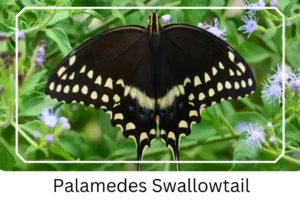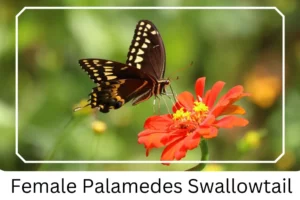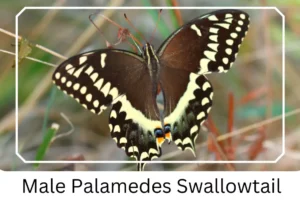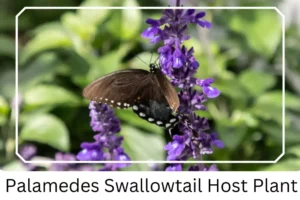Palamedes Swallowtail (Papilio palamedes)
The Palamedes Swallowtail, a majestic member of the swallowtail group, is a spectacle of nature known for its striking black appearance. Thriving in swampy areas, this butterfly offers an enchanting view from May through October, symbolizing the rich biodiversity of wetland ecosystems. In this comprehensive guide, we explore the world of the Palamedes Swallowtail, from its early stages as a caterpillar to its splendid adult form, providing an insightful overview for enthusiasts and researchers alike.
Scientific Classification
- Family: Papilionidae
- Genus: Papilio
- Common names: Laurel swallowtail
- Scientific Name: Papilio palamedes
Overview
Belonging to the species Papilio palamedes, the Palamedes Swallowtail is an emblem of the wild, untamed beauty found along the Atlantic coast, from New Jersey’s southern reaches to Florida, and extending through the Gulf Coast to central Mexico. Its lifecycle, marked by distinct stages of development, reveals the intricate balance of nature and the critical role of habitat and host plants in the survival of this butterfly. Let’s embark on a detailed exploration of its life stages, unique features, and the essential facts that make the Palamedes Swallowtail a fascinating subject of study.
Description and Identification
Caterpillar
The Palamedes Swallowtail caterpillar presents an intriguing appearance with its bright green dorsal side, adorned with pairs of light gray circles, and a reddish tan ventral side. The head features two prominent false eye marks designed to mimic the appearance of a predator’s eyes, alongside two yellow oval marks, giving it a serpentine illusion to deter threats.
Pupa
Transitioning into the pupa stage, it exhibits a green coloration with a distinctive whitish lateral stripe, bordered by brown, and is notable for the two horn-like structures atop its head. This stage heralds the transformation into a butterfly, typically occurring in early April.
Adult Butterfly
Sexual Dimorphism: Upon reaching adulthood, the Palamedes Swallowtail showcases its splendor with no visible sexual dimorphism.
Color and Appearance: The wings display a dazzling array of colors; when open, the dorsal side features bright yellow bands on both the hind- and forewings, complemented by yellow-tailed bases. The ventral side reveals a delicate yellow stripe along the base and a series of yellowish-orange crescents when the wings are closed.
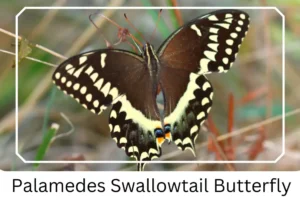
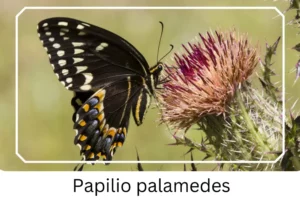 Average Wingspan: Ranging from 4½ to 5⅛ inches (11 to 13 cm).
Average Wingspan: Ranging from 4½ to 5⅛ inches (11 to 13 cm).
Flight Pattern: Their flight is moderate yet appears haphazard, adding to their mystique.
Eggs
The beginning of the lifecycle is marked by the laying of light-colored eggs on the leaves of host plants, ensuring the continuity of this remarkable species.
Quick Facts | |
| Distribution | Atlantic coast from southern New Jersey to Florida, and the Gulf Coast to central Mexico. |
| Habitat | Wet woods, rivers, lakes, and broadleaf evergreen swamp forests. |
| Lifespan of Adults | Approximately 14 days. |
| Host Plants | Primarily plants from the Laurel (Lauraceae) family, such as redbay (Persea borbonia). |
| Adult Diet | Nectar from flowers. |
How to Identify Palamedes Swallowtail?
Identifying a Palamedes Swallowtail butterfly involves looking for specific markings and colors unique to this species. The adult butterfly’s wings are predominantly black, with distinct bright yellow bands on both the hind- and forewings that are visible when the wings are spread. When the wings are closed, look for the yellow stripe along the base of the hindwing and the series of yellowish-orange crescents. The large wingspan, combined with the unique flight pattern, further aids in its identification. Observing these characteristics in their preferred swampy habitats, especially during their peak viewing months from May to October, can help enthusiasts and researchers alike distinguish the Palamedes Swallowtail from other butterfly species.
Did You Know?
- In Mexico, the Palamedes Swallowtail is represented by the subspecies P. p. leontis, highlighting the butterfly’s vast geographical range and adaptability.
- Despite its short adult lifespan of nearly 14 days, the Palamedes Swallowtail plays a significant role in pollination, contributing to the health of its habitat.
- The caterpillar’s false eye markings are not just for show; they are a sophisticated defense mechanism evolved to mimic the eyes of larger predators, deterring potential threats.
Conclusion
The Palamedes Swallowtail embodies the intricate beauty and complexity of nature. From its early days as a uniquely patterned caterpillar to its breathtaking transformation into an adult butterfly, each stage of its life cycle is a testament to the wonders of natural selection and adaptation. By understanding more about these creatures, their habitats, and their behaviors, we can appreciate the delicate balance of ecosystems and the importance of conservation efforts to protect such magnificent species.
Palamedes Swallowtail Pictures

Scientific Classification

- Family: Papilionidae
- Genus: Papilio
- Common names: Laurel swallowtail
- Scientific Name: Papilio palamedes

